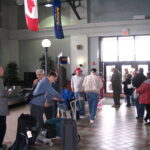The Case for Long-Distance Trains.
Arguing for the Amtrak long-distance network is a frustrating experience. The typical outraged and misinformed author of a letter-to-the editor or an op-ed column asks why the taxpayers should subsidize all those long-distance trains just so wealthy retirees and train buffs can ride across the country in luxury.
That, of course, is simply not true. Most of the passengers on Amtrak’s long-distance trains are riding in coach and most of them are traveling from one mid-point on the route to another. These aren’t wealthy vacationers, but rather they’re ordinary people for whom Amtrak is necessary public transportation. In fact, for many people all across the west and mid-west, an Amtrak long-distance train is very likely their only available public transportation.
Let’s consider a retired couple in their 70’s living in Kansas. Their daughter lives near Albuquerque with her husband, who is in the military. A new baby has just arrived and the grandparents want to visit their daughter and meet their first grandchild. They could fly, but it’s a 90-minute drive to the nearest airport—they would have to leave their car there—and the flight would involve a change of planes. At their ages, driving is not a reasonable alternative; it’s a 1000-mile round trip and their Toyota is 16 years old.
But there’s an Amtrak station in the neighboring town of Garden City. The Southwest Chief comes through once a day at 6:30 in the morning, and it will take them right to Albuquerque, arriving at about 4:00 that afternoon. If they leave next week, the round-trip coach fare for two seniors would be $476 or about $120 per person each way.
Now tell me those two retired people are somehow ripping off the American taxpayer!



Jim, by no means are the long haul trains a luxury, esp, these days. What they are doing is filling a gap in the transportation network for people who can’t or won’t fly, drive or bus, due to circumstances, sometimes beyond their control. So this notion that daily or tri-weekly or whatever trains are a luxury is bull. In my 33 yrs. of service to Amtrak, I have seen it all, & believe me not pretty , on those oversold long distance trains, with passengers sitting in diners & lounge cars waiting for seats to open up along the way. This was & I am still sure not “luxury travel”, as some like to think.